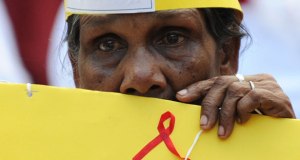
All of us who will be in Melbourne to attend the 20th International AIDS Conference (AIDS 2014) this month need to reflect on one question: What does “stepping up the pace” — the theme of the conference —mean?
With just a year left until 2015 — the end date for achieving the Millennium Development Goals (MDGs) and the commitments made under the UN Political Declaration of 2011— it is certainly time for that final push. But it’s also time to look beyond the 2015 goal post and reflect on what can be done to achieve an AIDS-free generation.
The gains made towards expanding coverage of life saving anti-retroviral treatment (ART) are commendable, but we still have a long way to go. Globally, only 38% of adults living with HIV and 24% of children living with HIV have access to treatment, as per the latest UNAIDS Gap report. We must certainly step up the efforts to expand the treatment, without losing the focus on prevention.
Much work is still required to protect the rights of people. Stigma and discrimination still persist. HIV-related restrictions on entry, stay and residence exist in 40 countries. Criminalization of key populations is also widespread.

ACCESS to and EFFECTS of social protection on workers living with HIV and their households: an analytical report. Download the report
For example, according to the UNAIDS Gap report, homosexuality is illegal in some 78 countries. It’s punishable by death in seven. Sex work is illegal in 116 countries. People who inject drugs are almost universally criminalized.
I have always maintained that the story of AIDS is not about numbers. It is about human beings. It is about people who are part of our lives.
We need to take note of what people living with HIV are experiencing. Do they receive the necessary information and services? Is HIV-related stigma and discrimination on the decline? According to the latest research, the answer to all of these questions is still “no.”
A recent ILO study on “Access to and effects of social protection on workers living with HIV and their households” carried out in Indonesia, Guatemala, Rwanda and Ukraine found that many people eligible for HIV-related benefits or assistance weren’t receiving them because they weren’t aware of the procedures or couldn’t understand them.
Together with stigma and discrimination, a lack of awareness about programmes or difficulty of accessing them rank as the top three barriers to accessing social protection for people living with HIV. Those barriers are even higher for groups such as informal workers, gay men, sex workers, transgender people, intravenous drug users, migrant workers and women in general.
Crucially, the study also showed that people who were able to access social protection programmes were better able to hold down jobs, keep their children in school and access their medication (ART).
Research is only useful if it leads to action. In this context, it is heartening to learn that countries have begun the process. Indonesia is using the findings of research in the development of its HIV and AIDS National Strategy and Action Plan 2015-2019.
I will be presenting the ILO research at AIDS 2014, Melbourne, which has a sharp focus on social protection. This is indeed welcome. People living with HIV need health insurance, not just medication—and they need employment as well as livelihood support. As we gear up to plan the AIDS response beyond 2015, we must step up and provide more than pills and condoms.
